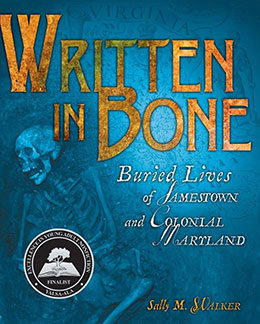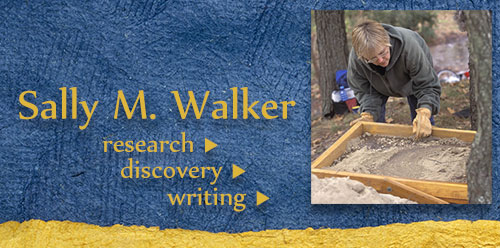
Written in Bone: Buried Lives of Jamestown and Colonial Maryland
About the Book
Bright white teeth. Straight leg bones. Awkwardly contorted arm bones. On a hot summer day in 2005, Dr. Douglas Owsley of the Smithsonian Institution peered into an excavated grave, carefully examining the fragile skeleton that had been buried there for four hundred years. “He was about fifteen years old when he died. And he was European,” Owsley concluded. But how did he know? Just as forensic scientists use their knowledge of human remains to help solve crimes, they use similar skills to solve the mysteries of the long-ago past. Join me as I work alongside the scientists investigating colonial-era graves near Jamestown, Virginia, as well as other sites in Maryland. As you follow their investigations, I’ll introduce you to what scientists believe are the lives of a teenage boy, a ship’s captain, an indentured servant, a colonial official and his family, and an enslaved African girl. All are reaching beyond the grave to tell us their stories, which are written in bone.
Behind the Book
When I was growing up, the lives of colonial Americans fascinated me. As my family visited places such as Williamsburg, Jamestown, and Valley Forge, I often imagined what it was like to live back then. I wondered what the people were like—how they looked and what activities they did.
Written in Bone tells the stories of eight colonists—their lives, deaths, and their place in our country’s history. Even though these people left little or no written record of their live, archaeologists and forensic anthropologists have learning about their lives by reading and revealing the stories that life and death have written in their bones. From these tales I discovered how truly tough life was in those days and gained great respect and admiration for the many different peoples whose sacrifices ultimately led to the birth of the United States. I have tried to capture the remarkable stories of these people in Written in Bone.
Awards and Recognition
- American Library Association (ALA) Notable Book
- ALA/YALSA Top Ten Best Books for Young Adults
- Benjamin Franklin Award 2010
- Chicago Public Library Best of the Best Book
- Cooperative Children’s Book Center Choices 2010
- Cybils finalist
- Moonbeam Children’s Book Award, Bronze Medal
- NCTE Orbis Pictus Award for Outstanding Nonfiction for Children, recommended book
- NCSS/CBC Notable Social Studies Trade Book for Young People
- National Science Teachers Association Outstanding Science Trade Books
- School Library Journal Best Book
- Science Books & Films Best Books
- Society of School Librarians International honor book in Social Studies 2009
- TAYSHAS Reading List
- Texas Library Association Lone Star Reading List
- YALSA Excellence in Nonfiction for Young Adults Award finalist
Reviews
“ The text succinctly explains complex forensic concepts, such as determining the gender and age of a skeleton, or whether a skull represents a person originating from Europe or Africa. Captioned, full-color photographs of skeletal, dental, and artifactual remains shed light on colonial life. Historical documents, illustrated maps, and anatomical drawings complement images of various specialists at work in the field. Photographs of reenactors performing period tasks, such as grinding corn, provide insight into the daily life of the recovered individuals. Though other recent volumes discuss forensic anthropology, such as James M. Deem’s Bodies from the Ice (Houghton, 2008), Written in Bone casts a magnifying glass on the hardships and realities of colonial life so often romanticized in American lore.” (School Library Journal, starred review)
“This unusual volume, suggested to Walker by a scientist at the Smithsonian Institution, dips into American history to introduce the work of forensic anthropologists. Focusing on colonial-era sites in the Chesapeake Bay region, the large-format book provides detailed discussions and intriguing close-up views of the grave excavations at Jamestown, Virginia, as well as in three Maryland locations: Providence, St. Mary’s City, and Harleigh Knoll. With precision of her own,Walker describes the meticulous work of the archaeologists and other scientists who study skeletal remains, using physical clues as indicators of a skeleton’s sex, age, birthplace, station in society, and length of time in the colonies. They combine trained observation, background knowledge, and scientific expertise with detective skills to illuminate facets of our history; the final chapter discusses how forensic anthropology has contributed to historians’ understanding of colonial times. Nearly every page carries at least one illustration, usually a color photo but sometimes a helpful diagram, a map, or a period document or print. Back matter includes source notes, a source bibliography, a time line, and lists of recommended books and Internet sites. The reading level is relatively high and the quantity of detailed information is not for everyone, but those intrigued by forensics and history will find this absolutely fascinating.” (Booklist, starred review)

written by Sally M. Walker
Carolrhoda Books, Jan 2009
hardcover: 978–0822571353
paperback: 978–0545068321
112 pages, ages 11 and up

